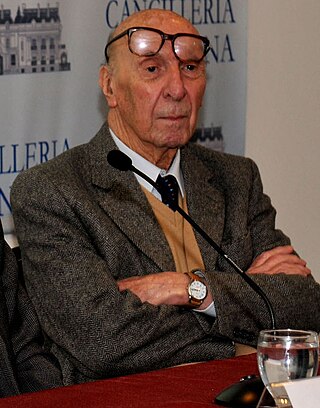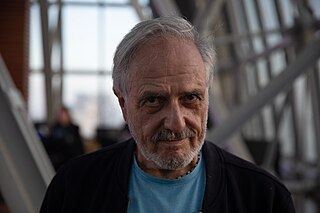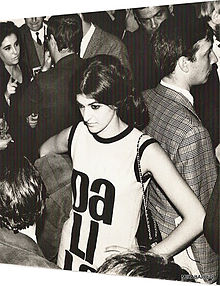
The Torcuato Di Tella University is a non-profit private university in Buenos Aires, Argentina. Founded in 1991, the university focused primarily on social sciences.

Clorindo Manuel José Testa was an Italian-Argentine architect and artist.

Gyula Kosice, born as Ferdinand Fallik, was a Czechoslovakian-born and naturalized Argentine sculptor, plastic artist, theorist, and poet. He played a pivotal role in defining the concrete and non-figurative art movements in Argentina and was one of the precursors of kinetic, luminal, and hyrdokinetic avant-garde art. His work was revolutionary in that it used, for the first time in international art scene, water and neon gas as part of the artwork.
Oscar Rubén Bony (1941–2002) was an Argentine avant-garde artist known for his innovative and daring work. Bony was a very active artist who exhibited his work often. He wanted his work to make a huge statement, by having the public experience the events occurring in Argentina's culture while capturing innocence, guilty, and the people being trapped. He wanted his people to open their eyes to the injustice that was happening to the people and how life was for the less fortunate.

Marta Minujín is an Argentine conceptual and performance artist.
The Torcuato di Tella Institute is a non-profit foundation organized for the promotion of Argentine culture.

Jorge Aníbal Romero Brest was an influential art critic in Argentina, who helped popularize avant-garde art in his country.

Roberto Jacoby is an Argentine artist and sociologist. Known for his conceptual art and social activism in Argentine politics, most of his work is collaborative such as his displays in Experiencias and participation in Tucumán Arde.

Rogelio Polesello was an Argentine painter, muralist and sculptor. He was best known for making Op art known in Latin America. He won two Konex Awards; one in 1982 and another in 2012. He was born in Buenos Aires.
Lea Lublin was an Argentine-French performance artist.

Delia Cancela is an Argentine pop artist and fashion designer. She has lived in Argentina, New York, London and Paris, and exhibited internationally. Retrospective exhibitions of her work and her collaborations with Pablo Mesejean include Delia Cancela 2000-Retrospectiva (2000), Pablo & Delia, The London Years 1970-1975 (2001), and Delia Cancela: una artista en la moda (2013).

Martha Boto was an Argentine artist. Boto was born in Buenos Aires, Argentina, and was co-founder of the Group of Non-Figurative Artists of Argentina. She is considered to be a pioneer of kinetic and programmed art.
Inés Katzenstein is an Argentine curator, art historian, and art critic who specializes in Latin American art.
Ana Kamien is an Argentine dancer, choreographer, and actor who based most of her works in Buenos Aires, Argentina. Kamien was known for challenging gender and class norms along with creating works that parodied classical ballet by mixing the dance style with contemporary dance.
Experiencias '68 was a controversial exhibition held at Instituto Torcuato Di Tella (IDTD) in Buenos Aires, Argentina, in May 1968, curated by Jorge Romero Brest. It included artwork by artists including Oscar Bony, Delia Cancela, Roberto Plate, and Roberto Jacoby. With this exhibition, the Institute was joining a growing movement among artists to make artwork that would challenge the government under Juan Carlos Onganía.
Rubén Santantonín (1919–1969) was an Argentine visual artist. Although he was active in the Pop art movement through his participation in Torcuato di Tella Institute, Santantonín's personal artwork was based more on conceptual and abstract idealism. His artworks tended to involve mixed media that would challenge the viewer's relationship with objects and materials.
Maria Gainza is an Argentine art critic and writer.
Diego Bianchi is an Argentinian visual artist. He lives and works in Buenos Aires, Argentina.
Silvia Torras (1936–1970) was a Spanish-born Argentine informalist painter. Torras became a notable artist in the Argentine informalism movement and showed her work in several major exhibits during the short period she painted.

Josefina Robirosa was an Argentine artist known for her paintings, murals, and drawings. She is considered one of Argentina's most prominent women painters.












